In Poetics Aristotle argues poetry arose on account of two intrinsic human instincts: an "instinct for 'harmony' and rhythm" and "the instinct of imitation", as in representation rather than copying, an imitation Aristotle opines is the method via which humans learn, and that "to learn gives the liveliest pleasure".
Yet while for Aristotle all forms of poetry are "in their general conception modes of imitation", again as in representation rather than copying, "they differ, however, from one another in three respects - the medium, the objects, the manner or mode of imitation".1
With the exhibition Mimesis. A Living Design the Centre Pompidou-Metz explores designers as imitators of nature, and the varying, and continually developing, mediums, objects, and manners or modes of that imitation.......
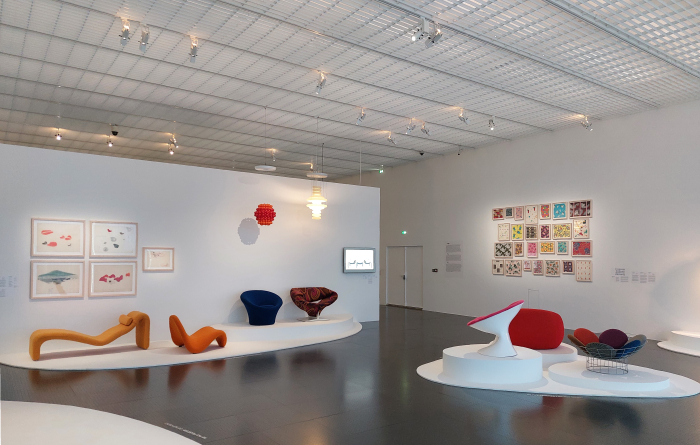
As a concept μίμησις, mimesis, imitation, as in representation rather than copying, was, arguably, first discussed by Plato, a man who was generally the opinion that everything in our physical world is and was but an imperfect imitation, representation, of a higher Form, an imperfect imitation, representation, of an archetype, before being taken on by Aristotle and subsequently developing over the centuries into a much debated and discussed subject amongst philosophers, literature critics, art critics and their ilk.
As an exhibition Mimesis. A living design takes you on an essentially chronological journey through the past 100+ years of design, primarily, though not exclusively, furniture design. An essentially chronological journey that however opens in the 2000s with the chapter Grotesques, an opening chapter which....... an opening chapter which we'll treat as the end chapter, which it also is, you enter you and leave Mimesis via Grotesques, which we hope would have amused Plato and Aristotle....... and begin in the chapter Cabinet of Curiosities, which although devoid of the unicorn horn that was once de rigueur in any cabinet of curiosities worthy of the name, does feature a collection of objects, books and projects which, if one so will, highlight connections between creativity and developing understandings of science and the natural world over the past 100+ years, including, for example, early 20th century photographs and films from the likes of Albert Renger-Patzsch, Germaine Dulac or Brassaï, more contemporary objects by Mathieu Lehanneur, Marcel Wanders or Aldo Bakker and also a miniscule robotic stingray developed by the Disease Biophysics Group at Harvard University from a combination of gold, algal protein, plastic and rat heart muscle cells.
And a cabinet of curiosities which, in many regards, also sets the scene for what is to come. But which you can't yet know, being as you are but at the beginning of your journey.
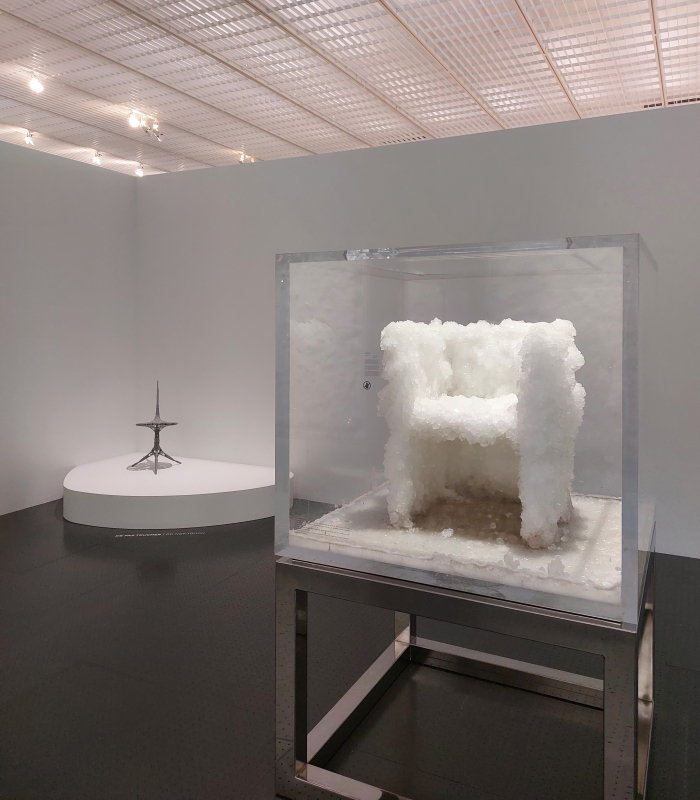
A journey, certainly a chronological journey, which, in effect, properly starts with the chapter Biomorphism, a chapter which opens with the claim that "in Scandinavia, in the early 1920s, the work of Alvar and Aino Aalto laid the foundations for organic design in a humanist approach that was inspired by the relationship between human beings and nature". A claim which although can be made, we'll argue, making it does involve ignoring an awful lot of late 19th/early 20th century designers who were very much "inspired by the relationship between human beings and nature" and who were also looking for more humane approaches. And who were most definitely inspired by nature, who most definitely imitated nature, often to absurd extremes. Whereby, and not unimportantly in terms of the development of design, in terms of design as an independent discipline, of design as separate from craft, whereas the Art Nouveauists attempted to humanise the harsher edges of late 19th century industrialisation through the practice and culture of furniture production as much as through the objects themselves, the Aaltos sought to humanise the harsher edges of International Modernism through the material of furniture, actively choosing wood for their furniture rather than the bent tubular steel of the International Modernist.2
Bent tubular steel that was once championed by Charlotte Perriand, who in 1929, famously, denounced wood as a "vegetable substance, bound in its very nature to decay" and thus unsuitable for future orientated furniture.3 Before, in the course of the 1930s and 40s she began to appreciate the virtues and advantages of not just vegetable substances but organic substances of all types; a developing appreciation that can be approached in Mimesis through examples of Perriand's nature photography, Perriand's portraits of naturally occurring objects, from the 1930s and also works from her time in Japan in the 1940s and 50s, a period also represented by contemporaneous works by the Japanese designers Kenzō Tange, Ubunji Kidokoro and Sōri Yanagi, the latter of whom served as an assistant to Perriand during her time in Japan in the early 1940s as an external advisor to the Japanese government on the development of local craft. An experience that saw Perriand recreate her and Le Corbusier and Pierre Jeanneret's steel tube and leather chaise longue in bamboo. An act that we're certain would have given both Plato and Aristotle plenty cause for reflection.
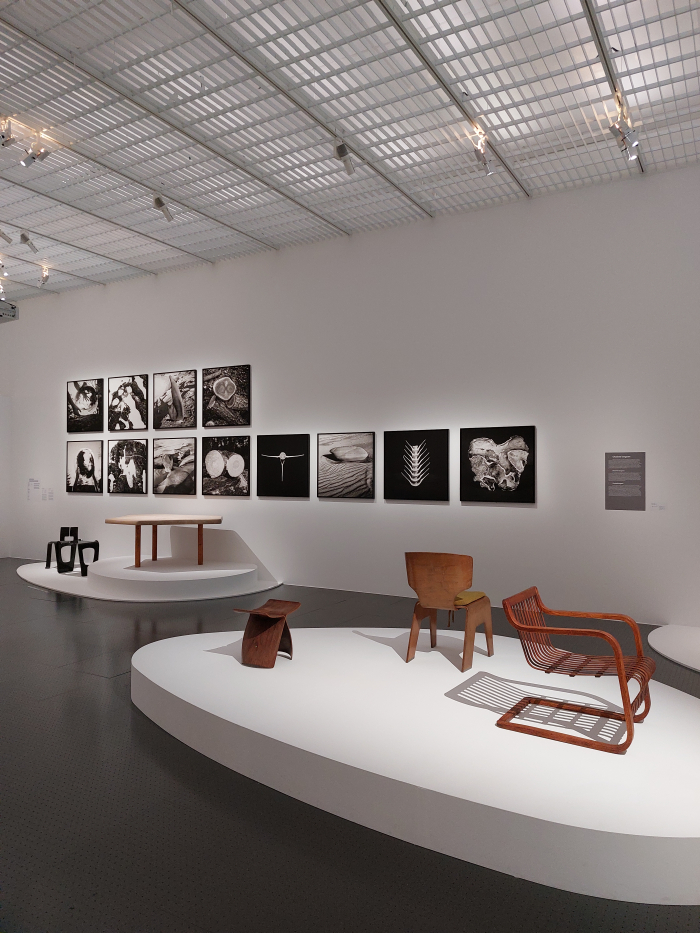
From Finland to France to Japan, Biomorphism crosses the Pacific to continue its discussion in context of what one could describe as post-War developments of an organic approach to design by American Designers, Designers américains, for all George Nelson, Harry Bertoia and the Eames, the latter of whom are represented by, amongst other projects, panels from their 1972 travelling exhibition Fibonacci: Growth and Form for IBM, and thus a welcome reminder that Charles and Ray are so much more than just furniture.
And a global tour through Biomorphism which, having briefly touched Italy, ends back in northern Europe with Scandinavian Design, Design scandinave.......
.......the linguists, les linguistes, amongst you will have spotted the very subtle difference in terminology between America and Scandinavia, between Designers américains and Design scandinave, and will very naturally, as we did, question why? Whereby the answer can't be, can it? That would be awful....... but we digress.......
.......a display of biomorphic Design scandinave dominated, in a very positive sense, by Vena Cuprum, a transient, volatile, monumental, absorbing work by Norwegian textile designer Gjertrud Hals which recreates a network of blood vessels from copper wire, iron wire and papier-mâché. And further dominated, certainly for us, by a 1953/54 prototype for a moulded, folded, casually squashed, aluminium chair by Poul Kjærholm, a Kjærholm chair that although not standing contrary to what he is popularly known for does tend imply a different approach, a different conceptual basis than that for which he is popularly known, and thereby enables an appreciation of the existence of a possible approach to a potentially differing understanding of Kjærholm. A work we admittedly obsessed over a tick more than we probably should have. Admittedly still are. And a work which can be seen very much reflected in, inverted in, Arne Jacobsen's 1958 Drop chair which stands next to Kjærholm's. Whereby we're not convinced Kjærholm's work though unrealised isn't the much better version.
And then as so oft in the (hi)story of (furniture) design, organic went Pop.
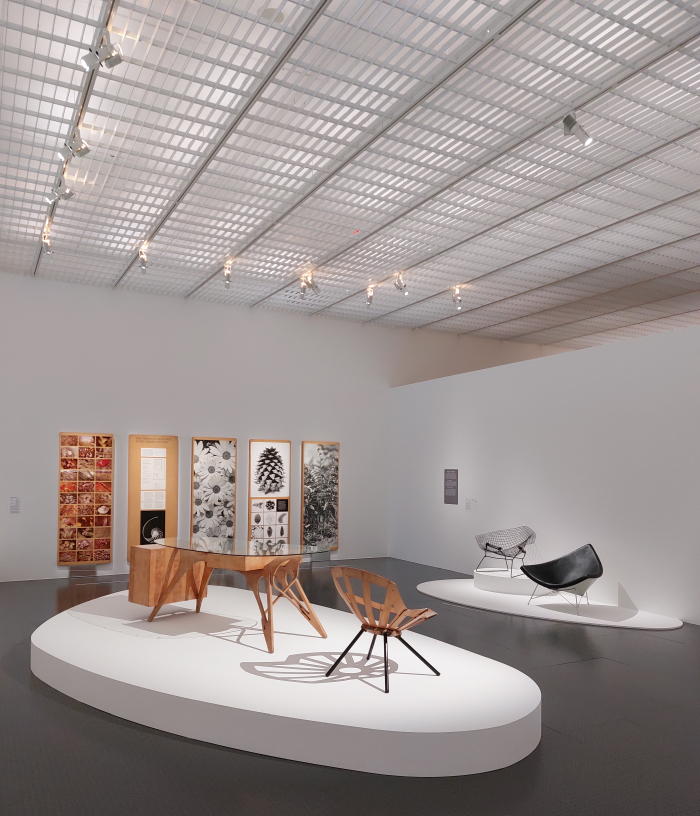
Yet as Mimesis tends to imply, the Popping of (furniture) design didn't result in any loosening of the associations with, nor reflections on, nature. In many regards it intensified them. If in more abstracted manners than before the Pop.
A Popping, a shift in position and approach, an abstracting of nature, that can be followed in Mimesis through works by, and amongst many other designers, Olivier Mourgue, Gaetano Pesce, Nathalie du Pasquier or, and somewhat inevitably, but no less welcomely, Verner Panton. And also via two landscapes, two (more or less) immersive spaces of the type that, arguably, weren't possible before art and design Popped, before the social and cultural developments that led to that Popping: specifically, Pierre Paulin's 1968 Déclive which although open very much creates a space within a space, and Superstudio's 1969/70 Bazaar as a room within a room, a poppy seed head in which you can sit. Poppy as in a member of the Papaveraceae. And as in Pop.
And a shift from a direct reference to the natural world to more abstracted relationships with the natural world which as design, and society, moved away from the audacious rebellion of the 1960s and 1970s shifted again; Mimesis helping elucidate that as the Pop faded designers began employing a more direct quoting of nature in much more direct manners, began employing actual nature yet never nature directly as itself, that would be diegesis....... probably.
And an essentially Postmodernist shift, something tending to be underscored not only by Superstudio's Papaveraceae-esque Bazaar as a herald of coming developments, but also by the presence in the chapter Nature at Work by the likes of Andrea Branzi or Philippe Starck, the latter's 1988 W.W. stool representing, reimagining, a theoretical, idealised, tree root as an aluminium perch, thus underscoring the difference between diegesis and mimesis....... probably. But certainly the difference between direct use and quoting. And a shift taken on by later generations, perhaps most satisfyingly by Ronan and Erwan Bouroullec's ever engaging Algae room divider, a project we've never considered in context of Postmodernism, but which one can, and a project which although presented in Mimesis in a manner that allows it to explain what it physically is and technically is, and to explain its playful mimicry, simply cannot allow it to explain what it intrinsically is, simply cannot allow it to unveil its true beauty and eloquence. For that they have to actually divide a space. While not separating it. And a work which in its use of repeating units and the manner in which it can not only be freely assembled but continually reassembled also allows for reflections on the question, and as opined from Organizing Things at the Werkbundarchiv – Museum der Dinge, Berlin, if modular is not perhaps the truest form of organic design.
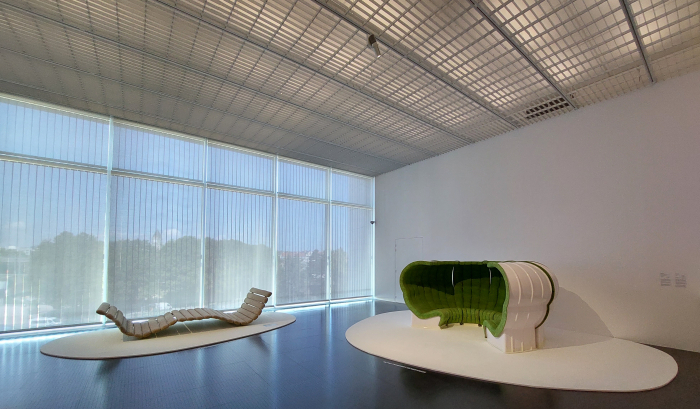
Mimesis ends with two, technically three chapters, four chapters, on contemporary relationships between nature and (furniture) design: Digital Re-creation, Bio-manufacture, and the aforementioned Grotesques. Chapters which discuss novel materials, novel production process, novel construction approaches, et al arising from or emulative of nature and natural processes, and through projects by designers as varied as, and amongst a great many others, Olivier van Herpt, Samuel Tomatis, Lilian van Daal, Ross Lovegrove or Tokujin Yoshioka. And also ends with the Cabinet of Curiosities which you should visit again at the end. Not least because viewing the cabinet in context of all that you have witnessed since your last visit, allows you to much better appreciate the degree to which developments outwith design are related to developments inwith design, the relationships between design and other creative, scientific, technical or philosophical practice. And allows you to reflect on the question, if novel developments such as x-rays or macro photography were once important in allowing us to understand and thereby imitate nature, where, for example, could artificial intelligence or protein sequencing or a miniscule robotic stingray, or things yet unknown, take design in the future. Yes, take design forward positively and/or negatively. For amid Aristotle's extolling of "the liveliest pleasure" given by learning/imitation, we should always heed Plato's warnings of the dangers of imitation. On the dangers on mimesis.4
Along the way Mimesis takes three slight detours, one to the mid-20th century French lighting designer Serge Mouille whose formal studies not only remind very much of the sort of projects design students carry out in the early semesters at near all design schools, but also underscore why such isn't just messing about but actually about approaching more nuanced personal understandings of spatial relationships, proportions, scales etc; and whose three late 1950s cylindrical metal lamps remind very much of an Isamu Noguchi in their interplay of solidness and lightness, of the opaque and the transparent. And in doing so highlight that Noguchi isn't in the exhibition, although very well could be, would arguably provide for an excellent mid-Pacific stepping stone between Japan and les Designers américains.
A second detour through a selection of Ronan and Erwan Bouroullec's Rêveries Urbaines, those urban daydreams which are, arguably, partially based on developing more sustainable relationships with nature, of employing and stimulating innate human relationship with nature as the basis for a more sustainable urban planning. And Rêveries Urbaines which are slowly becoming Réalités Urbaines as ever more projects are realised.
And a third detour to two presentations of chaise longues, one of, essentially, pre-War, analogue, works by Bruno Mathsson, Hans J Wegner and Alvar Aalto....... we'll get to that, you know we will....... the other of, essentially, post-War, hi-tech, works by Aurélie Hoegy, Joris Laarman and Charles & Ray Eames. Presentations which in addition to stimulating a Wet Leg earworm, an ever welcome resident in our ears and which simply adds to the enjoyment of Mimesis, also provides for a very neat summery of the ever shifting basis of the relationships between nature and design, of the ever shifting basis of design's imitation of nature as discussed in Mimesis.
A nature, as with a mimesis, that it can be helpful and informative to approach from an Aristotelian perspective.
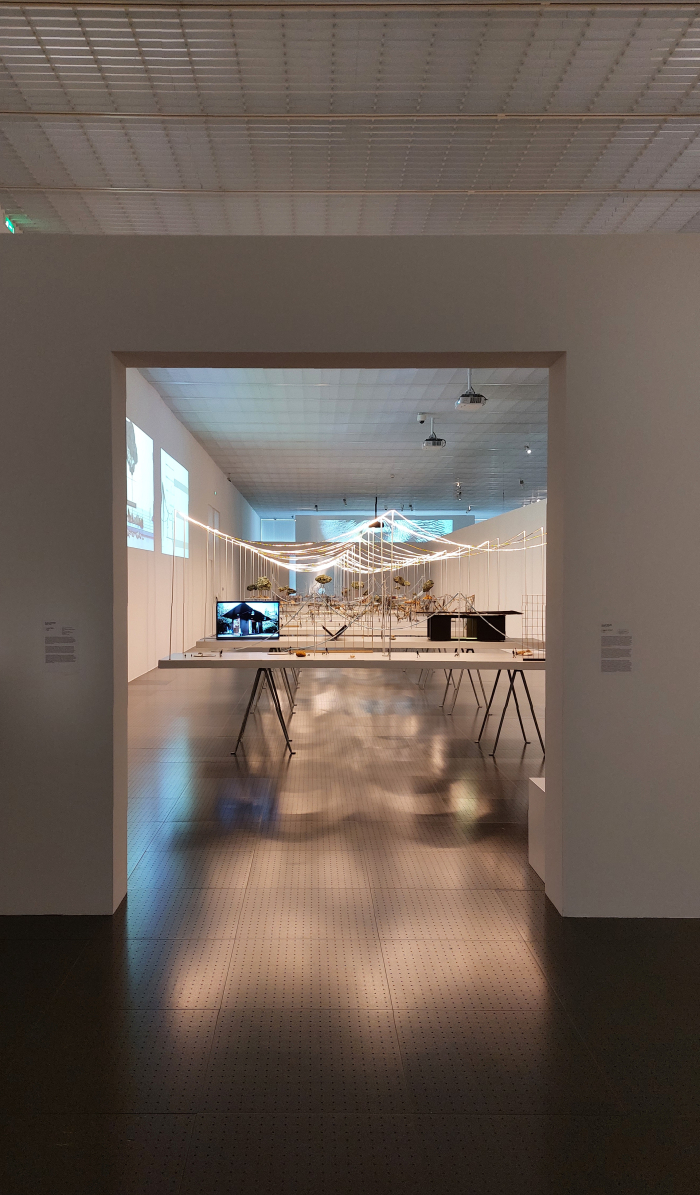
"Some things exist, or come into existence, by nature; and some otherwise", opines Aristotle in Physics, before arguing that what distinguishes the two is that things which exist, or come into existence, by nature rather than via "some otherwise", "have within themselves a principle of movement (or change) and rest - in some cases local only, in others quantitive, as in growth and shrinkage, and in others again qualitative, in the way of modification".5 Which brings us back to the Bouroullec's Algae and modularity in design, which very much have "within themselves a principle of movement (or change) and rest". If just not autonomously. Or not yet, as noted above where could artificial intelligence or protein sequencing or a miniscule robotic stingray, or things yet unknown, take design in the future? What novel imitations of nature could artificial intelligence or protein sequencing or a miniscule robotic stingray, or things yet unknown, enable? Could Aristotle's assertion that "...men propagate men but bedsteads do not propagate bedsteads..."6 become an outdated argument? Could we one day grow more Bouroullecian Algae from existing stock? Or train our shelving systems to add a new layer as the existing become ever fuller?
Aristotle further arguing in Physics that ""nature" may be understood (as signifying either "material" or "form")"7, thereby introducing two of Aristotle's Four Causes, Aristotle's theory of causality, theory of why?; and arguments on form, material and nature that bring him to the questions: "Which of the two aspects of Nature is it that claims the attention of the physicist? Or is his subject the compositum that combines the two?"8
And is it form or material that claims the attention of the designer? Is it imitation of the forms or the materials of nature that claims the attention of the designer? Or is the designers' subject the compositum?
¿?
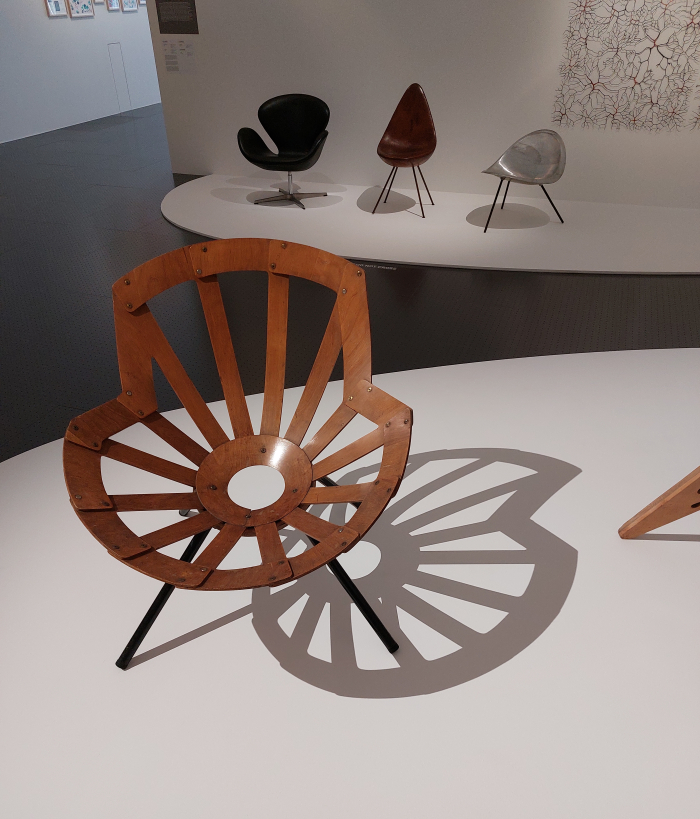
Viewing Mimesis one tends, certainly we tended, to an understanding that while natural forms have without question been, and are still, relevant for the nature imitating designer, if arguably not as relevent as they were for the undiscussed Art Nouveauists, for all those of French or Scottish dialect, much more important, and becoming increasingly so, is the structure that underscores that form and the construction process that leads to and supports it: that in nature, and by imitation in design, form may or may not follow function, but form regularly follows construction. And also allows for reflection on the fact that the flowing curves of Pop, those design forms most popularly associated with natural forms were (largely) enabled by synthetic plastics: an inorganic material enabling more organic forms than had previously been possible in furniture design's imitation of nature. Which if Alanis Morissette is reading, is actually ironic. And a state of affairs that also helps Mimesis elucidate the key role of materials in the development of design, in the development of our objects of daily use: the wood from which we have been making furniture for centuries, dominates, unsurprisingly, the earliest parts of Mimesis' timeline, before in the course of Mimesis finding itself joined by ever new materials, as it will continue to do so going forward. And as discussed from Plastic: Remaking Our World at the Vitra Design Museum, we will, potentially, depending on industry and governments, increasingly see ever more novel plastics become available for the production of our goods of daily use and increasingly replace our contemporary synthetic plastics, novel plastics based upon naturally occurring materials and organisms.
Albeit, materials and organisms we can only imitate from nature, can only learn from nature, as long as nature is still there.
And forms and structures and construction processes we can only imitate from nature, can only learn from nature, as long as nature is still there.
Which, no, isn't us just being defeatist.
As an exhibition Mimesis, and its concentrated focus on design and nature, and its regular references to design and natural forms and natural material, very much helps foster thoughts on another, less celebrated but no less important relationship between design, certainly industrial design, and nature. And regularly poses the question, given the various and varied ways nature inspires design why do designers allow their work to have such negative impacts on the environment? Designer's aren't neutral in any given space or time.
Thoughts and questions also contained in the reflections fostered in Mimesis on the other two of Aristotle's Four Causes: "the purpose or end and the means to that end".9
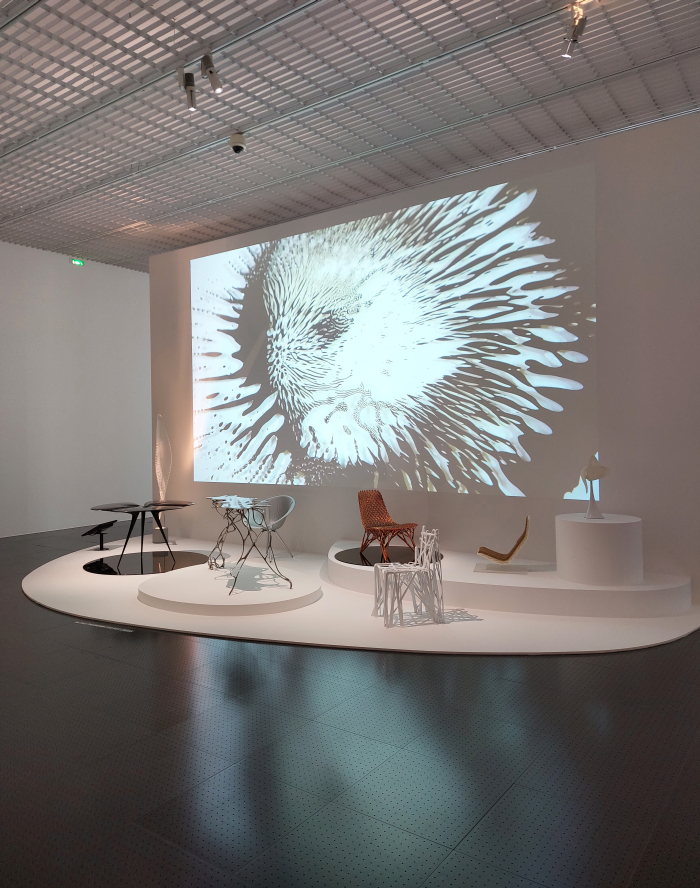
In terms of the latter viewing Mimesis one tends to an understanding that in context of design not just the designer is an agent, but also the scientist, the engineer, and wider society are agents in the genesis of an object, are that which allows a thing to become.
Or put another way, throughout the course of its presentation, over the century or so of Mimesis' timeline, you can follow how technological, scientific, social and cultural developments have impacted on design and allowed designer's ever more options in their approach to their work, opened new conceptual and physical paths, highlighted restrictions and compromises and misunderstandings in the works of previous generations, and also flagging up problems with contemporary generations. Technological, scientific, social and cultural developments that while not always directly of and from nature, are often related to developments in our relationships with nature. And which in doing so both helps elucidate that the relationships between design and nature are in many regards a component of evolving societies, and also helps underscore that although going forward we may, will, see a re-evaluating of much of what is, and will be, in terms of the production of our objects of daily use, steps back to what was aren't an option, arguably are not possible; rather developments in society, science, technology et al mean it will be a case of the familiar in new guises and fresh contexts. Which tends too underscore the importance of us all carefully considering and critically questioning the path we are on. It may be a one way path. Certainly on with only limited room for turning.
And the former? The "purpose or end", the why are we creating this?
¿?
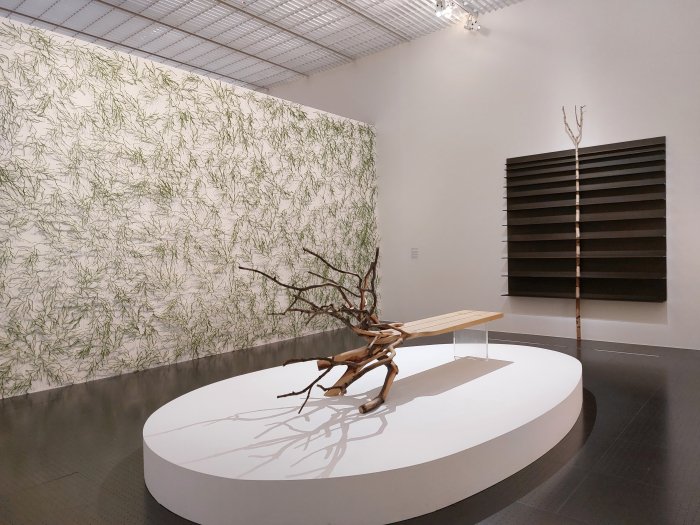
Not a Cause approached directly in Mimesis, but inarguably a question all designers need to ask themselves every day, as a matter of course before beginning any given project, because the superfluous doesn't exist in nature, or to remain with Aristotle, "... God and nature create nothing that does not fulfil a purpose"10. And is, inarguably, the manner of imitation of nature, certainly Aristotelian nature, with the greatest contemporary relevance.
And may very well be the future path design takes; it may very well be that having imitated nature over the past century primarily in terms of form, material (and means), we may move increasingly to imitating nature in terms of defining in advance the necessity, or otherwise, of that which we do. A move towards, an increased focus on, the "purpose or end" which one can understand occurring in context of developing social and cultural contexts and positions, the aforementioned understanding fostered by Mimesis of the continually evolving relationship between design and nature as a component of continually evolving societies.
And a move towards, an increased focus on, the "purpose or end" which involves a move away from the accursed objectification of design. Away from imitation in design as copying not representing. Away from imiation in design as commerce not culture. Imitation not as a path to learning but a path to (hoped for) profit. And a move Mimesis tends to encourage through the great many short texts describing the objects, their genesis, the positions and contexts in and from which they developed, and thereby not only greatly aiding and abetting the viewing of the exhibition but also helping focus attention on the individual object as being more than form and material and by agents and thereby enabling more focussed considerations and reflections on what is design, on the place and function of design in society in the course of the 100ish years of Mimesis' timeline, and in the decades going forward.
Or put another way, what were the human instincts that caused design to arise? Arguably an "instinct for 'harmony' and rhythm", and beyond that? And what instincts does design have to satisfy if it is to remain relevant? And what happens if other instincts are satisfied? What becomes then of our objects of daily use? Our societies?
Such aren't questions for a Plato or an Aristotle, but for us all, individually and collectively.
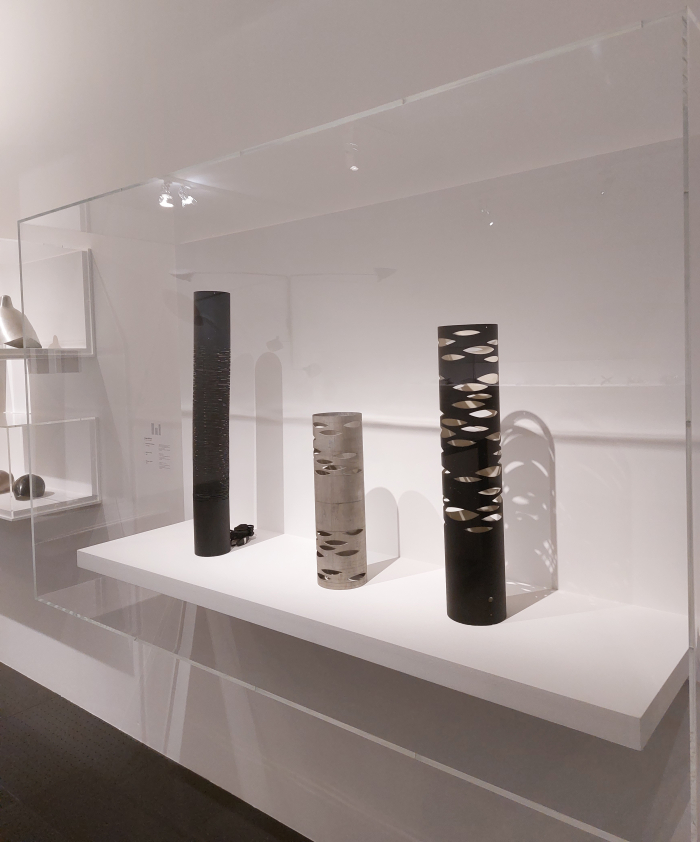
An accessible and neatly paced trilingual, French, English, German, presentation, staged in a building designed by Shigeru Ban and Jean de Gastines which also has something of a stingray about it, albeit an over-dimensional stingray, and a building design which through its many references to nature can also be considered part of the presentation, one of the particular joys of Mimesis is the wide variety of objects, projects and positions from the past 100ish years it presents; although very much an exhibtion with a theme, themes, it is also one that can be enjoyed for the opportunity it provides to get up close and personal with a lot of works that you don't meet every day, an opportunity to engage in dialogue with works you didn't know. And to re-engage in a new context with those you are familiar with.
For all an excellent opportunity to engage/re-engage with design from France, a country which has a very long tradition in design, which has contributed greatly and importantly and meaningfully to the development of design, to design positions, to design understandings and to definitions of design over the course of Mimesis' timeline, and which will continue to do so. But a France which is all to quickly overlooked in favour of a Denmark or an Italy or an America. Mimesis is a reminder, a demand, to stop doing that. And to look further than the few names you know. Or the few popular works by those few names.
And just as importantly, Mimesis allows for focussed, stimulating, reflections and considerations aon not only the study of nature as being an intrinsic component of design (hi)story, but also on the varied and various ways over the past century and a bit imitation of nature has contributed to the development of (furniture) design, on the continually evolving and developing imitation of nature in context of the medium, the objects, or the manner or mode.
If, by necessity, as an exhibition Mimesis generalises heavily. The movement it follows from Biomorphism to Bio-manufacture is one that can be made but which in making it does involve ignoring an awful lot of components which don't fit, representing positions with but a limited number of objects which may or may not be representative of the designer's wider oeuvre, and for all involves ignoring that design is accumulative not consecutive; positions and approaches don't cease to exist just because new ones arise, you just have more, which continually influence and inform one another. Thus increasingly blurring any path through design (hi)story as you move closer towards your own age.
Which isn't a complaint, just an observation. Our complaint is the fact Mimesis does that thing with the Aaltos, that thing of ascribing the 1936 chaise longue Nr. 39 to Alvar aalone, and indeed ascribing all the Aalto works featured to Alvar aalone, while noting in a text with the heading Alvar Aalto "...the pared-down designs of Alvar Aalto and his wife, the designer and architect Aino Aalto....". Under the heading Alvar Aalto. Next to works accredited to Alvar aalone. A trick, an ignoring of Aino while placing her in full public view, originally developed by the MoMA New York in 1938.11 And which is one of those thought errors that we really, really need to move on from.
As is the one about understanding nature as something we need to be master of, something to control and harness, rather than understanding nature as that which enables and advances human life, of nature as an equal partner on planet Earth with whom we should be cooperating in a respectful, equitable, accommodating manner.
Nature as something, as Mimesis ably demonstrates, we can learn from, we have learned from; a learning, as Mimesis further ably demonstrates, we as a species have greatly benefited from: Mimesis very neatly and competently and entertainingly helping elucidate how through learning by imitation from nature, we have continually developed not only our objects of daily use, but ever new approaches to and methods of producing our objects of daily use, and thereby enabled ever more functionalities and relationships of and with those objects. With all the consequences that has had not just for us as individuals, but on the development of our cultures and societies.
And a nature Mimesis tends to argue, tends to admonish, we still have an awful lot to learn from.......
Mimesis. A living design is scheduled to run at the Centre Pompidou-Metz, 1, Parvis des Droits de l'Homme, 57000 Metz until Monday February 6th
Full information, including information on opening times, ticket prices, current hygiene rules, and details of the accompanying fringe programme can be found at www.centrepompidou-metz.fr/mimesis-a-living-design
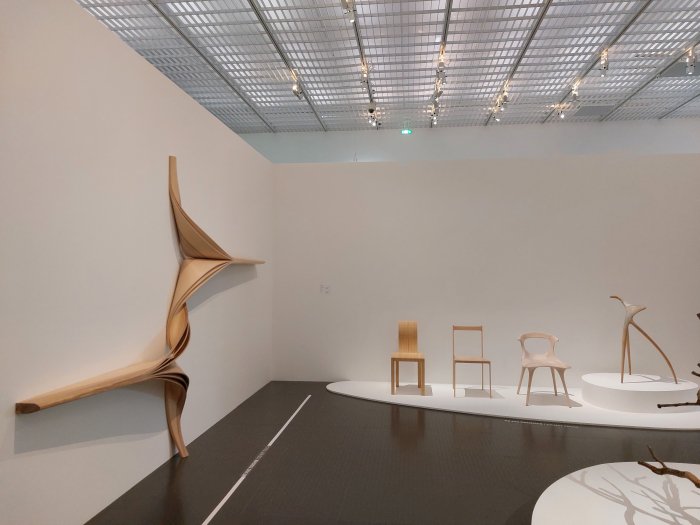
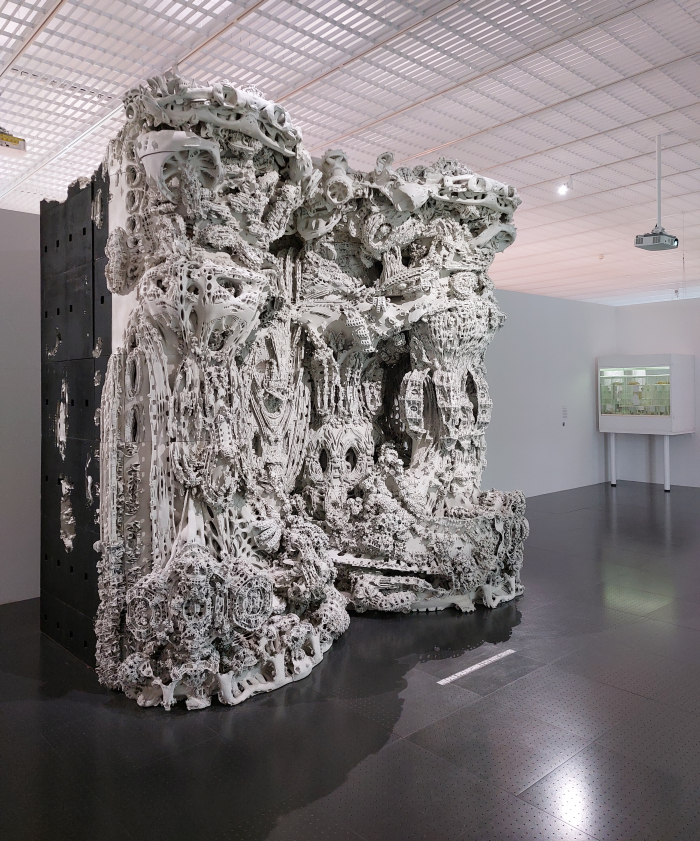
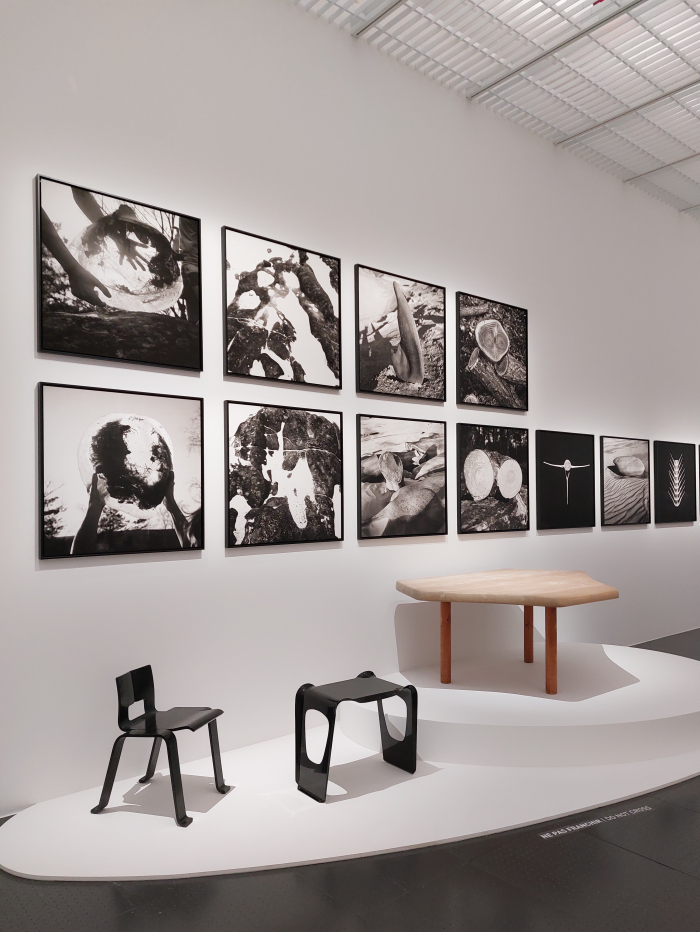
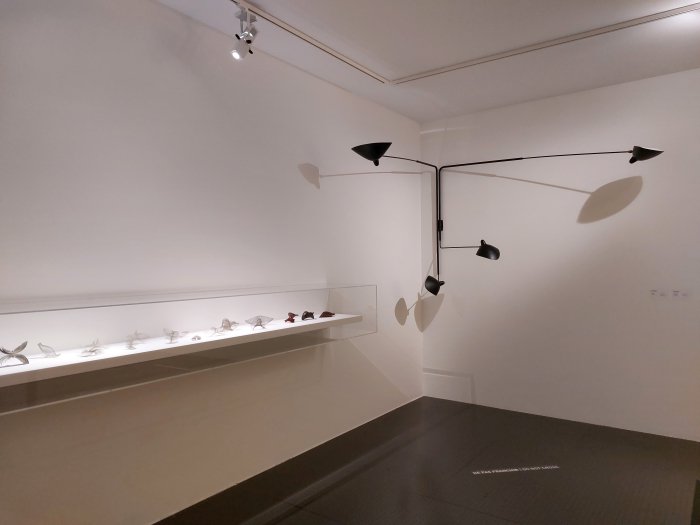
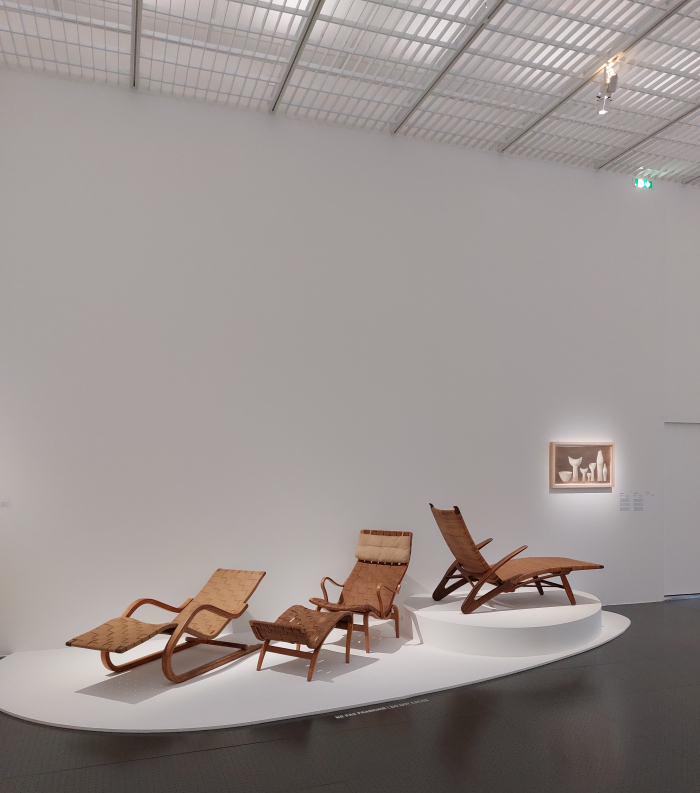
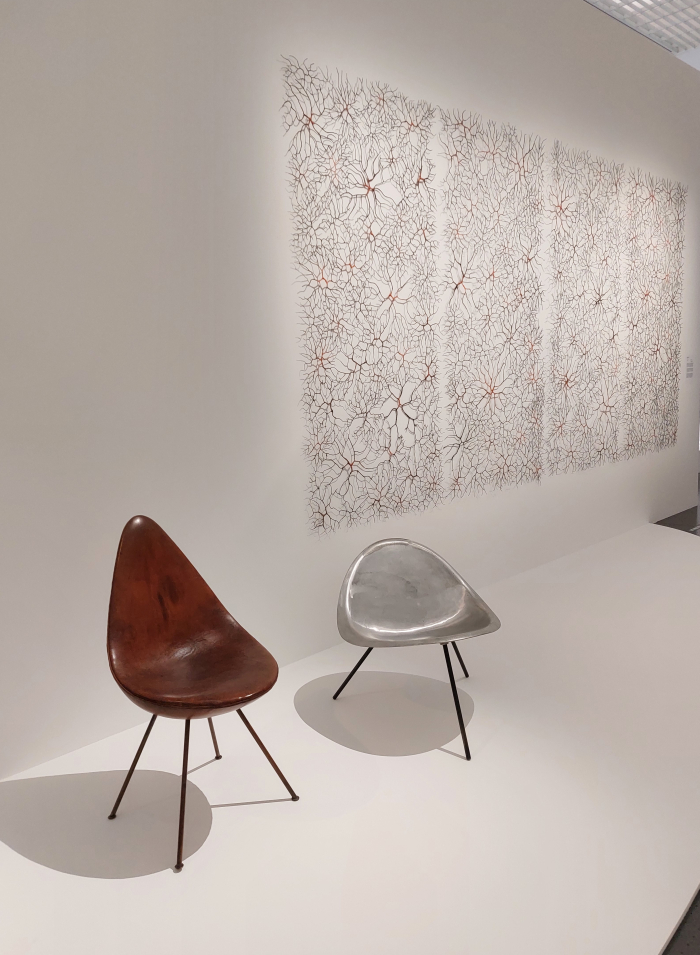
1Aristotle, Poetics, Part 4, Translated by S. H. Butcher, Fourth Edition Macmillan and Co, London, 1922 With ancient Greek the possibilities for translation are near limitless. That we can't translate ancient Greek, or rarely try, we rely here on the translations of others, which although invariably vary in choice of words from other translations, the meaning should, largely, always be the same. And so if you search around you may find a formulation more to your personal liking. There are a lot out there.
2see, for example, Alvar Aalto, The Humanizing of Architecture – Functionalism must take the human point of view to achieve its full effectiveness, Technology Review, Volume 43, Number 1, November 1940
3Charlotte Perriand, Wood or Metal? The Studio Vol 97 No. 433 1929
4see, for example, Plato The Republic, for all Book III and Book X
5Aristotle. The Physics, Book II, Chapter I, Translated by Philip H. Wicksteed and Francis M. Cornford, Harvard University Press/William Heinemann Ltd, 1963
6ibid
7ibid Book II, Chapter II
8ibid
9ibid
10Aristotle, On the Heavens, Book I Chapter IV, Translated by W. K. C. Guthrie, Harvard University Press/William Heinemann Ltd, 1965
11The catalogue for the 1938 MoMA New York exhibition Alvar Aalto: Architecture and Furniture notes, without an apparent sense of irony, embarrassment or self-reflection: "1925 Marriage with architect Aino Marsio; all works after this date are in collaboration with Mrs. Aalto." Yet the exhibition covering the period from ca 1930 i.e. after that date, is titled Alvar Aalto: Architecture and Furniture. See Architecture and furniture: Aalto, Museum of Modern Art, New York, 1938 Available via www.moma.org/calendar/exhibitions/1802 (accessed 22.08.2022)